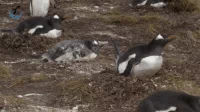The Smelly Science of Tracking the Movements of
Microplastics
NOAA
This
is a harder question to answer than it may seem. When we think of plastic
pollution, most of us think of large pieces of plastic floating at the surface
of the ocean, but that’s only a piece of the puzzle.
Plastic
can be found at every depth in the ocean. Some of that plastic does float, but
some drifts underwater, and some sinks all the way down to the ocean floor. It
is especially hard to keep track of the smallest pieces of plastic,
microplastics less than 5mm in size.
Recent
research is revealing that those microplastics are being moved not just by
currents and weather, but by animals through their digestive tracts.
We know animals out in the ocean are eating plastic, and many of us have seen the pictures of plastic in the bellies of sea birds, sea turtles, and whales.
Larger
pieces of plastic can become stuck in an animal’s stomach, making it hard for
them to eat, while microplastics tend to pass right on through the animal.
Sea
birds are especially prone to snacking on plastic. More than 100 species of sea
birds have been confirmed to eat plastic.
A recent study of seabirds of the coast of Canada’s
Labrador peninsula has found that they are also pooping out plastic, and about
half of the birds studied had microplastics in their poop. This is potentially
an issue because of where the birds are pooping.
These
birds feed all over the north Atlantic, and then return to their rocky island
roosts. Tens of thousands of birds gather together, and poop together.
In essence, these birds are collecting microplastics from wide swaths of the ocean, and concentrating them in one place. These plastic-eating birds could be creating rings of plastic pollution around their colonies.
In essence, these birds are collecting microplastics from wide swaths of the ocean, and concentrating them in one place. These plastic-eating birds could be creating rings of plastic pollution around their colonies.
It’s
not just birds that are eating and pooping plastic. Some of the smallest
animals in the ocean, zooplankton, could also be moving plastic as they move
their bowels.
Researchers looked at zooplankton living in the Monterey Bay off the coast of California. With their small, nearly transparent bodies, it was easy for researchers to see brightly colored plastic in the zooplankton’s guts.
Researchers looked at zooplankton living in the Monterey Bay off the coast of California. With their small, nearly transparent bodies, it was easy for researchers to see brightly colored plastic in the zooplankton’s guts.
Researchers
also examined the fecal pellets expelled by the small creatures, and once again
found microplastics. Zooplankton habits may also be influencing how these
microplastics move through the ocean. The specific type of zooplankton studied,
larvaceans, tend to have poop that sinks rapidly at an estimated 1,000 feet per
day, when they are microplastic free.
Scientists
are still researching how microplastics affect the rate at which the poo drops.
In this particular study, they did find that although the microplastics
themselves didn’t sink, the microplastic-rich fecal pellets had no problem
dropping to the bottom of the zooplankton’s holding container.
This
means that these little critters could be transporting microplastics from near
the ocean’s surface down to the briney depths of the ocean floor.
Zooplankton,
sea birds, and hundreds other species of animals are eating, and presumably
pooping, plastic every day. It is going to take a lot more research and looking
at animal feces to figure out how this affects the plastic pollution problem
that is imperiling our ocean and Great Lakes.
But
there is one thing that’s certain: you can help keep plastic out of the ocean
and out of animals’ bellies! Join a cleanup, reduce the amount of single-use
plastic you use, and always to remember to dispose of any plastic waste
properly, no matter where you live.
Together we can make the seas, and also animal’s intestines, free of debris.
Together we can make the seas, and also animal’s intestines, free of debris.
